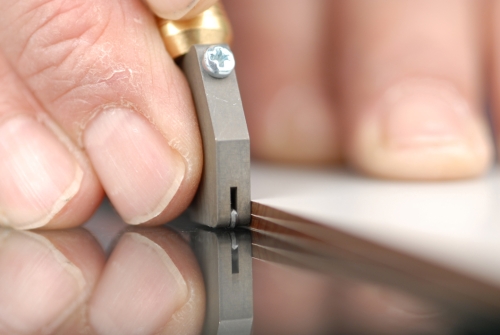Wheeled glass cutters are essential for creating glass mosaics. I put it to use to cut and form vitreous a glass and stained glass. This may also be used to slice smalti. The wheeled blades make cleaner cuts than tile nippers. The two carbide wheels (or steel, if you buy cheap cutters) are fixed in position. Instead of scoring and breaking, the wheels apply even pressure to the top and bottom edges of the glass, causing it to fracture along the line of the wheels.

The wheels are replaceable and eventually go dull, however, not before several thousand cuts. Each wheel is held in place by a setscrew (usually an Allen screw). As your cuts become significantly less clean than when the cutters that is were new, use an Allen wrench tool to loosen the anchoring screws, rotate each wheel about 1/8-inch, and then re-tighten the screws. By altering the location of where each wheel touches the glass, you have, in effect, replaced the blades. It'll take a long time and many cuts to use the complete circumference of the wheels, especially if they're carbide.
When the rims finally do become boring, I would recommend buying a entire new tool. The tires make up the bulk of the tool's cost, therefore you won't save much by simply buying replacement wheels. Having a brand new tool, not only are the wheels sharp, nevertheless the rubber handle grips are new and clean (the rubber wears down and becomes dirty) and the spring is secured in-place. Every now and then, the springtime breaks free from my cutters. The tool still works with a loose spring, but there's nothing to keep the handles from spreading too far apart. When that happens, the spring falls off. It can quite annoying to decline the spring, watch it bounce out of attain, and then have to get out of my chair to retrieve it. I tried soldering it permanently in place, but it didn't work because I couldn't get the metal hot enough. Therefore, until I obtain a new tool, the spring constantly falls off. Another reason to buy a new tool rather than just replacement wheels is, if you drop the tool, it's possible to knock the wheels out of alignment. Therefore , after several projects when you think the rims need replacing, I suggest buying a whole new tool.
When your new tool arrives, how to use Allen wrench to tighten the anchoring screws as tight as possible. Then, use an engraver, paint, felt-tip marker (or whatever you have that makes a long term mark) to make a little tick mark on the side of each wheel where it variations the glass when slicing (the two tick signifies should be aligned opposing each other). I personally use an engraving tool for making the tick marks so I avoid have to worry about paint or ink eventually rubbing off. After a few hundred cuts, ease the screws, turn each wheel slightly, and then re tighten the anchoring screws. After several of these adjustments, the tick marks have hot full circle suggesting that it's time to replace the tool (or just the wheels, if you prefer).
Don't be surprised if the wheels rotate independently. No matter how hard I turn down on those anchoring screws, it apparently isn't limited enough because the wheels slowly rotate by themselves from the pressure exerted during the cutting action. Right after several days and many cuts, I spot the beat marks are no longer aligned directly opposite each other, signifies the tires have rotated slightly. Might be I'm a weakling, but I just can't get the screws tight enough to keep them stationary. Nevertheless , that's okay with me because, if they turn by themselves, then I don't have to by hand do it.
No comments:
Post a Comment